Fundamentals of Multimedia
ISBN: 0130618721
Ze-Nian Li and Mark S. Drew
School of Computing Science
Simon Fraser University
Exercise Solutions
cPrentice-Hall, Inc., 2003
�
Contents
1 Introduction to Multimedia
2 Multimedia Authoring and Tools
3 Graphics and Image Data Representations
4 Color in Image and Video
5 Fundamental Concepts in Video
6 Basics of Digital Audio
7 Lossless Compression Algorithms
8 Lossy Compression Algorithms
9 Image Compression Standards
10 Basic Video Compression Techniques
11 MPEG Video Coding I — MPEG-1 and 2
12 MPEG Video Coding II — MPEG-4, 7 and Beyond
13 Basic Audio Compression Techniques
14 MPEG Audio Compression
15 Computer and Multimedia Networks
16 Multimedia Network Communications and Applications
17 Wireless Networks
18 Content-Based Retrieval in Digital Libraries
i
1
3
11
15
34
37
44
52
59
64
68
74
78
82
88
92
98
102
�
Chapter 1
Introduction to Multimedia
Exercises
1. Identify three novel applications of the Internet or multimedia applications. Discuss why you think
these are novel.
Answer:
WML – Wireless markup Language.
Mobile games: massive multiplayer online role-playing game (Mmorpg)
Multisensory data capture
Capture of context
Represent and adjust recollections in memory over time
“Fictive Art” in new media: beyond RPGs in the use of narrative and fictions to create made-up
worlds, imaginary situations, and odd situations (an example is “The Museum of Jurassic Tech-
nology”).
Bridging the semantic gap problem in automatic content annotation systems — the gulf between
the semantics that users expect and the low-level features (content descriptions) that systems
actually use: one solution is “an approach called computational media aesthetics. We define
this approach as the algorithmic study of a variety of image, space, and aural elements em-
ployed in media ... based on the media elements usage patterns in production and the associated
computational analysis of the principles that have emerged while clarifying, intensifying, and
interpreting some event for the audience.” (IEEE Multimedia Magazine, Volume: 10, Issue: 2,
Year: April-June 2003)
2. Briefly explain, in your own words, “Memex” and its role regarding hypertext. Could we carry out
the Memex task today? How do you use Memex ideas in your own work?
Answer:
Memex was a theoretical system explicated by Vanevar Bush in a famous 1945 essay. His main
ideas involved using associative memory as an aid for organizing a weler of material. He even
adumbrated the concept of links.
3. Your task is to think about the transmission of smell over the Internet. Suppose we have a smell
sensor at one location and wish to transmit the Aroma Vector (say) to a receiver to reproduce the
same sensation. You are asked to design such a system. List three key issues to consider and two
applications of such a delivery system. Hint: Think about medical applications.
1
�
2
Chapter 1. Introduction to Multimedia
Answer:
“October 6, 2000 – DigiScents, Inc., the pioneer of digital scent technology, received the ‘Best
New Technology’ award for its iSmell(TM) device at the ‘Best of RetailVision Awards’ at the
Walt Disney World Dolphin Hotel in Lake Buena Vista, Fla. Retailers such as BestBuy, Ra-
dioShack, CompUSA and other industry giants voted on the vendor awards.”
“DigiScents ... The company would send you a dispenser about the size of a computer speaker.
You’d plug it into your PC. It would be filled with chemicals that, when mixed, could recreate
most any smell. Tiny bits of data would come in over the Net to tell your dispenser what smell
to make. There would be a portal where you could find scents. DigiScents calls it – and at first I
thought they were joking – a ‘Snortal.’”
4. Tracking objects or people can be done by both sight and sound. While vision systems are precise,
they are relatively expensive; on the other hand, a pair of microphones can detect a person’s bearing
inaccurately but cheaply. Sensor fusion of sound and vision is thus useful. Surf the web to find out
who is developing tools for video conferencing using this kind of multimedia idea.
Answer:
“Distributed Meetings: A Meeting Capture and Broadcasting System,” Ross Cutler, Yong Rui,
Anoop Gupta, JJ Cadiz Ivan Tashev, Li-wei He, Alex Colburn, Zhengyou Zhang, Zicheng Liu,
Steve Silverberg, Microsoft Research, ACM Multimedia 2002,
http://research.microsoft.com/research/coet/V-Kitchen/chi2001/paper.pdf
5. Non-photorealistic graphics means computer graphics that do well enough without attempting to make
images that look like camera images. An example is conferencing (let’s look at this cutting-edge
application again). For example, if we track lip movements, we can generate the right animation
to fit our face. If we don’t much like our own face, we can substitute another one — facial-feature
modeling can map correct lip movements onto another model. See if you can find out who is carrying
out research on generating avatars to represent conference participants’ bodies.
Answer:
See: anthropic.co.uk
6. Watermarking is a means of embedding a hidden message in data. This could have important legal
implications: Is this image copied? Is this image doctored? Who took it? Where? Think of “mes-
sages” that could be sensed while capturing an image and secretly embedded in the image, so as to
answer these questions. (A similar question derives from the use of cell phones. What could we use
to determine who is putting this phone to use, and where, and when? This could eliminate the need
for passwords.)
Answer:
Embed retinal scan plus date/time, plus GPS data; sense fingerprint.
�
Chapter 2
Multimedia Authoring and Tools
Exercises
1. What extra information is multimedia good at conveying?
(a) What can spoken text convey that written text cannot?
Answer:
Speed, rhythm, pitch, pauses, etc...
Emotion, feeling, attitude ...
(b) When might written text be better than spoken text?
Answer:
Random access, user-controlled pace of access (i.e. reading vs. listening)
Visual aspects of presentation (headings, indents, fonts, etc. can convey information)
For example: the following two pieces of text may sound the same when spoken:
I said “quickly, come here.”
I said quickly “come here.”
2. Find and learn 3D Studio Max in your local lab software. Read the online tutorials to see this soft-
ware’s approach to a 3D modeling technique. Learn texture mapping and animation using this product.
Make a 3D model after carrying out these steps.
3. Design an interactive web page using Dreamweaver. HTML 4 provides layer functionality, as in
Adobe Photoshop. Each layer represents an HTML object, such as text, an image, or a simple HTML
page. In Dreamweaver, each layer has a marker associated with it. Therefore, highlighting the layer
marker selects the entire layer, to which you can apply any desired effect. As in Flash, you can
add buttons and behaviors for navigation and control. You can create animations using the Timeline
behavior.
4. In regard to automatic authoring,
(a) What would you suppose is meant by the term “active images”?
Answer:
Simple approach: Parts of the image are clickable.
More complex: Parts of the image have knowledge about themselves.
(b) What are the problems associated with moving text-based techniques to the realm of image-
based automatic authoring?
3
�
4
Chapter 2. Multimedia Authoring and Tools
Answer:
Automatic layout is well established, as is capture of low-level structures such as images
and video. However amalgamating these into higher-level representations is not well un-
derstood, nor is automatically forming and linking appropriate level anchors and links.
(c) What is the single most important problem associated with automatic authoring using legacy
(already written) text documents?
Answer:
Overwhelming number of nodes created, and how to manage and maintain these.
5. Suppose we wish to create a simple animation, as in Fig. 2.30. Note that this image is exactly
Fig. 2.30: Sprite, progressively taking up more space.
what the animation looks like at some time, not a figurative representation of the process of moving
the fish; the fish is repeated as it moves. State what we need to carry out this objective, and give a
simple pseudocode solution for the problem. Assume we already have a list of (x; y) coordinates for
the fish path, that we have available a procedure for centering images on path positions, and that the
movement takes place on top of a video.
Answer:
\\ We have a fish mask as in Figure \ref{FIG:MASKANDSPRITE}(a), and
\\ also a fish sprite as in Figure \ref{FIG:MASKANDSPRITE}(b).
\\ Fish positions have centers posn(t).x posn(t).y
currentmask = an all-white image
currentsprite = an all-black image
for t = 1 to maxtime {
\\ Make a mask fishmask with the fish mask black area
\\ centered on position posn(t).x, posn(t).y
\\ and a sprite fishsprite with the colored area also moved
\\ to posn(t).x, posn(t).y
\\ Then expand the mask:
currentmask = currentmask AND fishmask \\ enlarges mask
currentsprite = currentsprite OR fishsprite \\ enlarges sprite
\\ display current frame of video with fish path on top:
�
currentframe = (frame(t) AND currentmask) OR currentsprite
}
5
(a)
(b)
Fig. 2.30: (answer) Mask and Sprite.
6. For the slide transition in Fig. 2.11, explain how we arrive at the formula for x in the unmoving right
video RR.
Answer:
if x=xmax t=tmax, then we are in the right-hand video. The value of x is to the right of xT ,
and the value in the unmoving right-hand video is that value of x, reduced by xT so that we are
in units with respect to the left of the right-hand video frame. That is, in the right-hand video
frame we are at position x − xt, which is x − (xmax t=tmax).
7. Suppose we wish to create a video transition such that the second video appears under the first video
through an opening circle (like a camera iris opening), as in Figure 2.31. Write a formula to use the
correct pixels from the two videos to achieve this special effect. Just write your answer for the red
channel.
Fig. 2.31: Iris wipe: (a): Iris is opening. (b): At a later moment.
(a)
(b)
�
6
Chapter 2. Multimedia Authoring and Tools
Answer:
y ˆ
________________
____
(
)
( R1 )
(____)
| | R0
| |
| |
| |
| |
| |
| |
| |
|
|
|
|
|
|
|
|
|
-----------------
----------------> x
radius of transition r_T = 0 at time t = 0
r_T = r_max = sqrt( (x_max/2)ˆ + (y_max/2)ˆ2 )
at time t=t_max
--> r_T = r_max * t / t_max
At x,y,
r = sqrt( (x-x_max/2)ˆ2 + (y-y_max/2)ˆ2 )
If ( r < (t/t_max)*r_max )
R(x,y,t) = R1(x,y,t)
Else
R(x,y,t) = R0(x,y,t)
8. Now suppose we wish to create a video transition such that the second video appears under the first
video through a moving radius (like a clock hand), as in Figure 2.32. Write a formula to use the
correct pixels from the two videos to achieve this special effect for the red channel.
Fig. 2.32: Clock wipe: (a): Clock hand is sweeping out. (b): At a later moment.
(a)
(b)
�

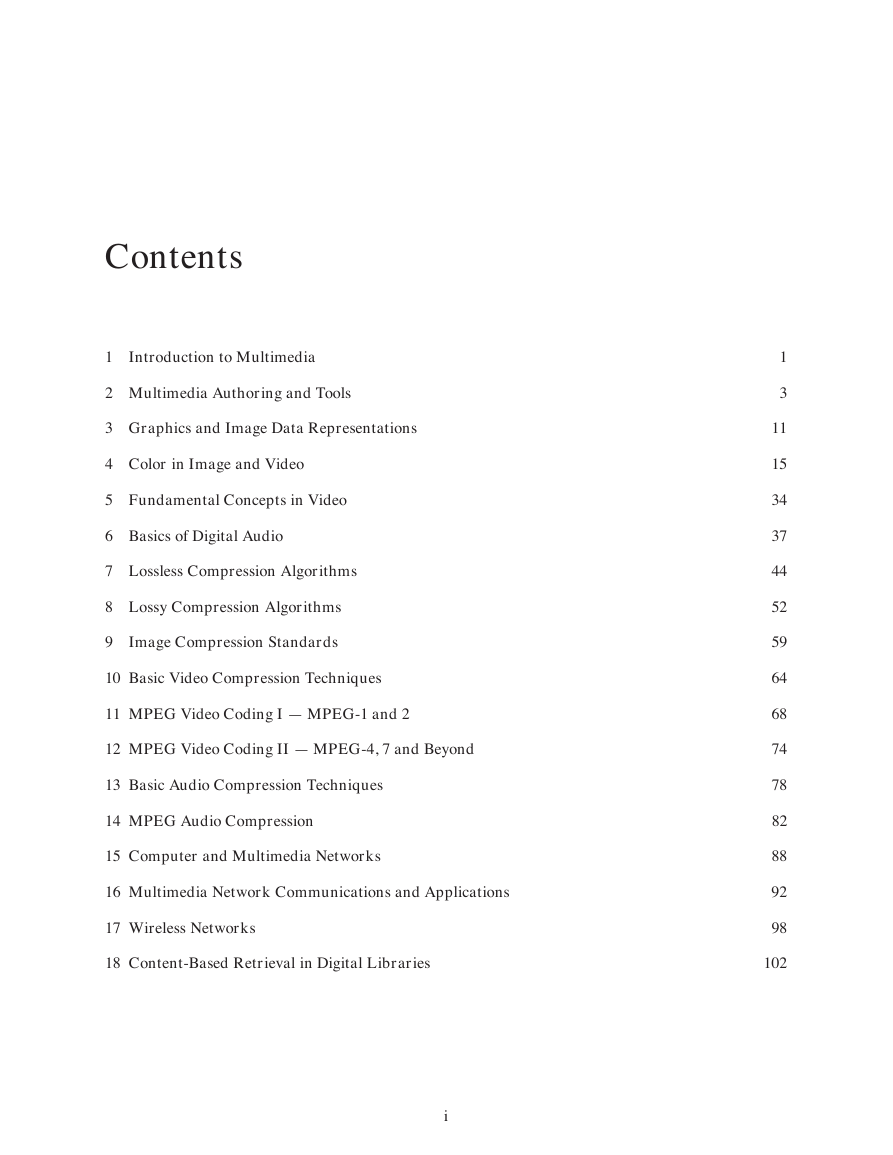
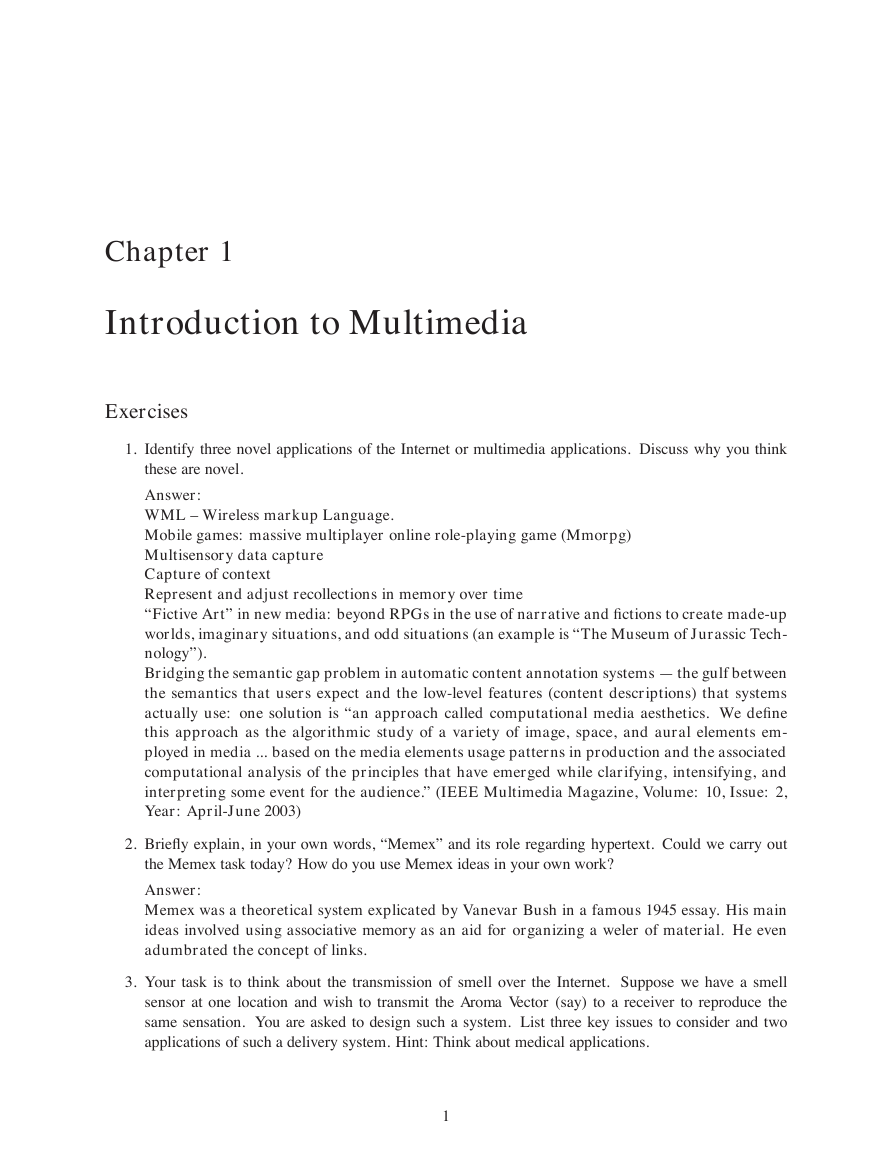
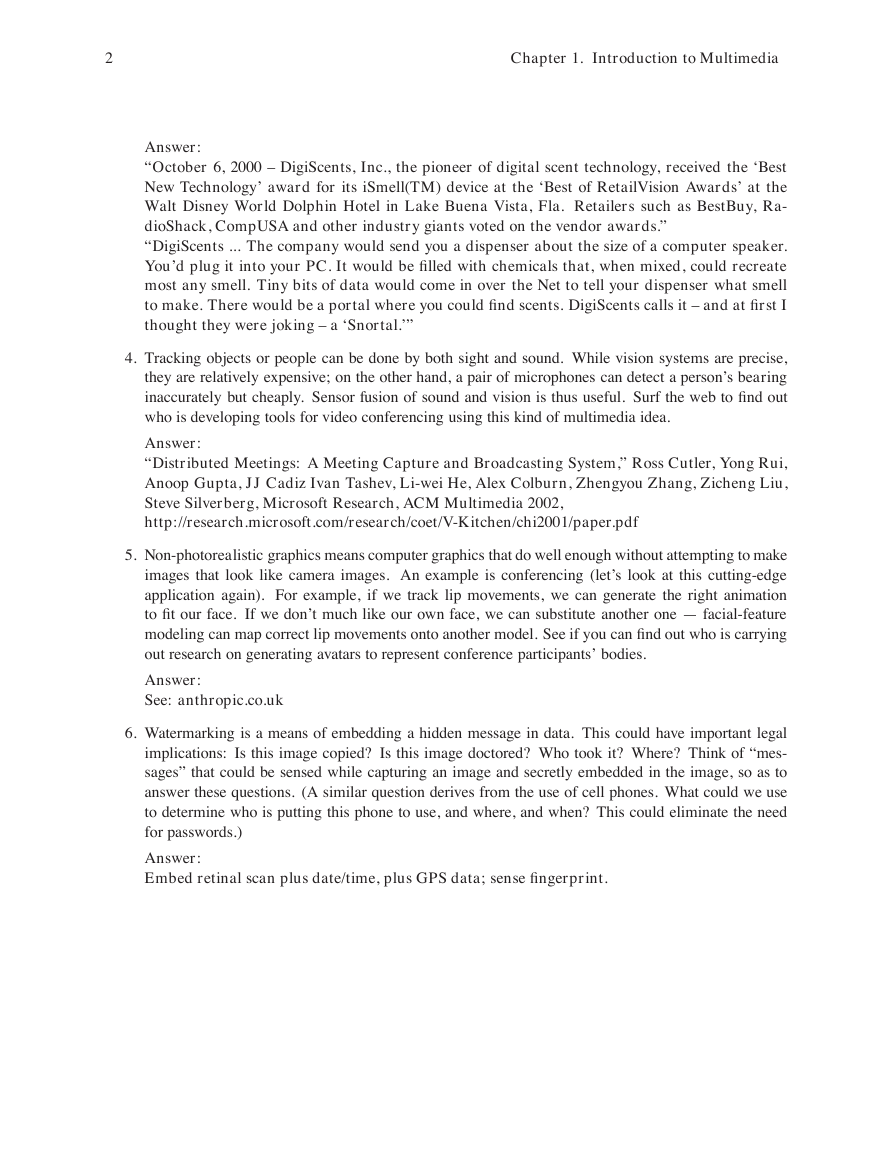
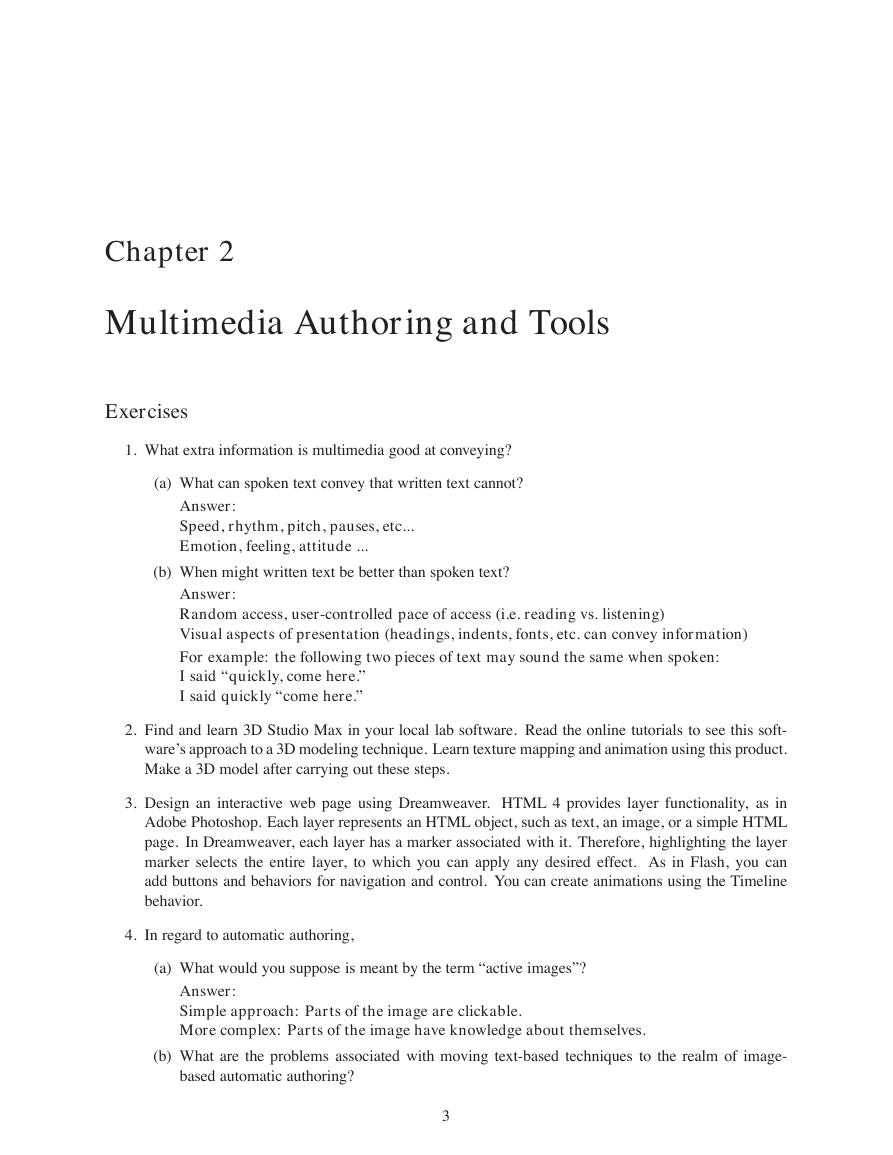
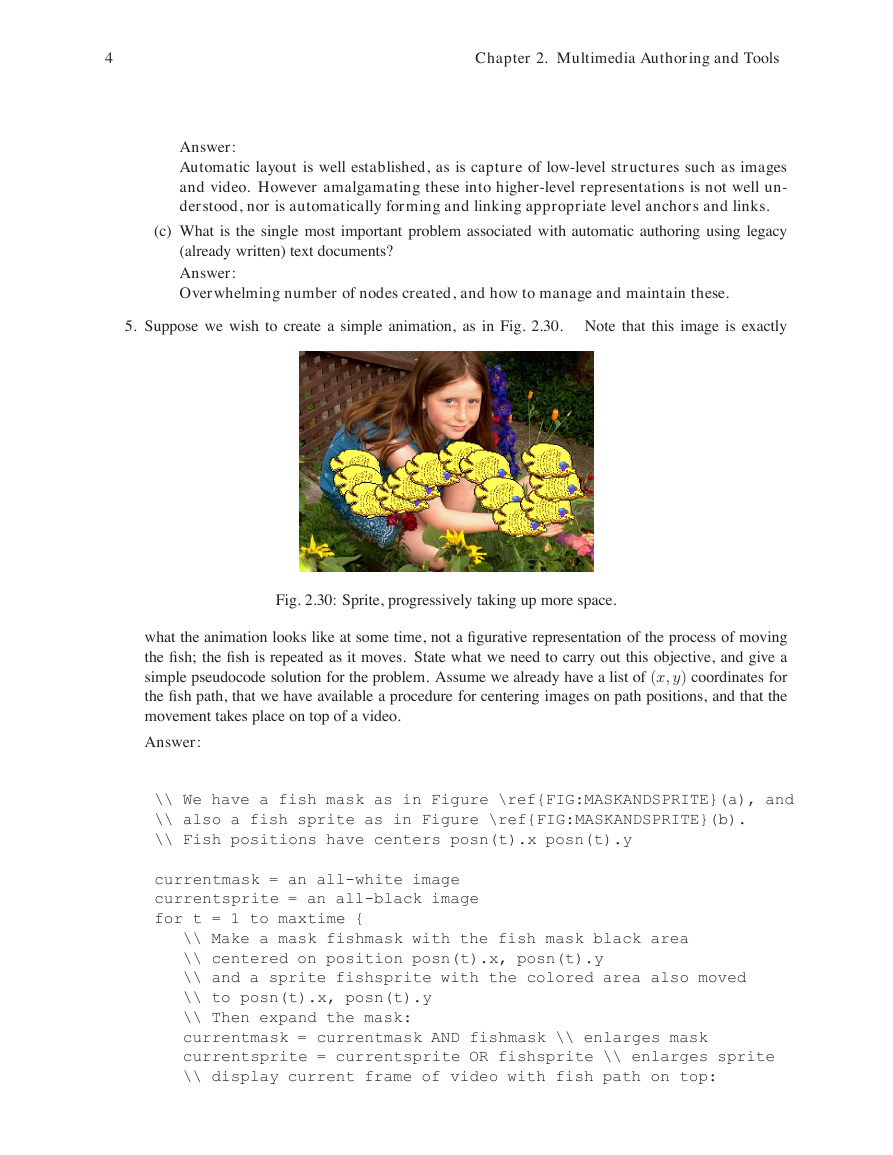
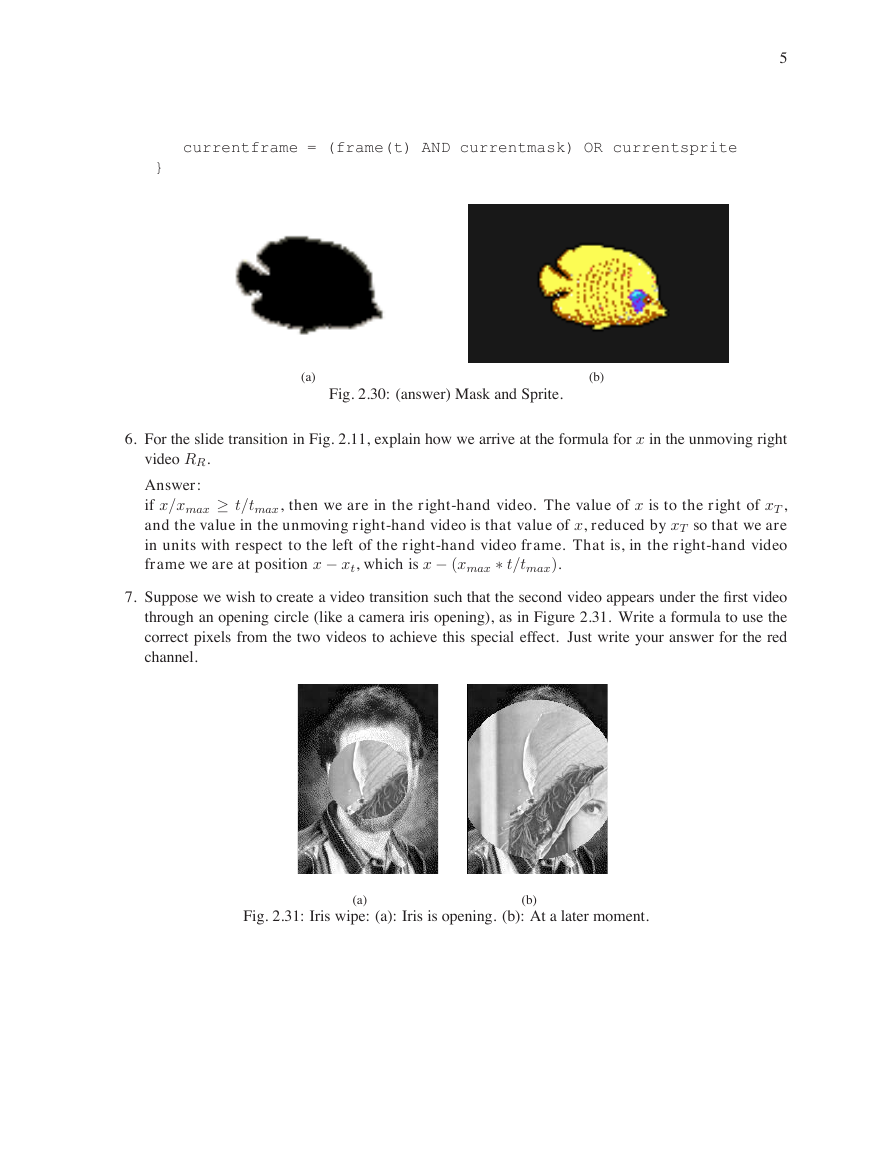
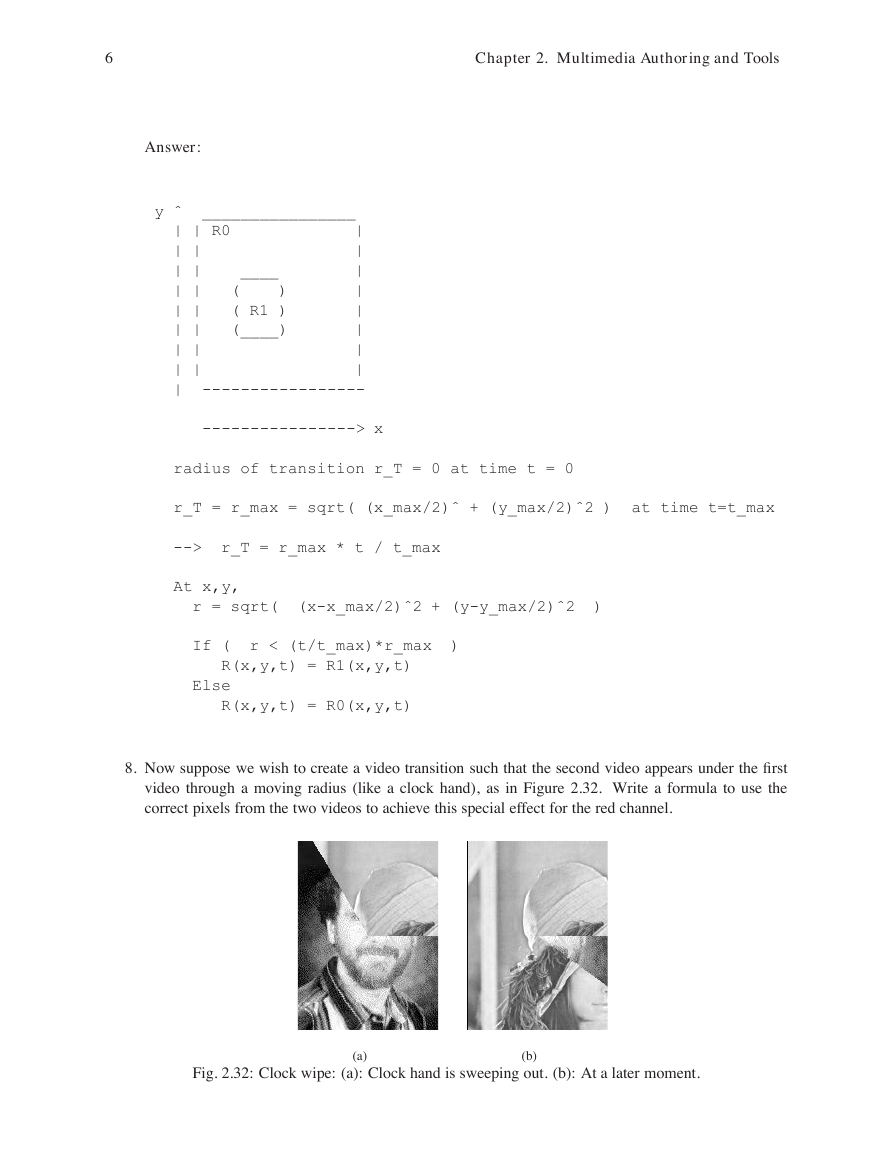








 2023年江西萍乡中考道德与法治真题及答案.doc
2023年江西萍乡中考道德与法治真题及答案.doc 2012年重庆南川中考生物真题及答案.doc
2012年重庆南川中考生物真题及答案.doc 2013年江西师范大学地理学综合及文艺理论基础考研真题.doc
2013年江西师范大学地理学综合及文艺理论基础考研真题.doc 2020年四川甘孜小升初语文真题及答案I卷.doc
2020年四川甘孜小升初语文真题及答案I卷.doc 2020年注册岩土工程师专业基础考试真题及答案.doc
2020年注册岩土工程师专业基础考试真题及答案.doc 2023-2024学年福建省厦门市九年级上学期数学月考试题及答案.doc
2023-2024学年福建省厦门市九年级上学期数学月考试题及答案.doc 2021-2022学年辽宁省沈阳市大东区九年级上学期语文期末试题及答案.doc
2021-2022学年辽宁省沈阳市大东区九年级上学期语文期末试题及答案.doc 2022-2023学年北京东城区初三第一学期物理期末试卷及答案.doc
2022-2023学年北京东城区初三第一学期物理期末试卷及答案.doc 2018上半年江西教师资格初中地理学科知识与教学能力真题及答案.doc
2018上半年江西教师资格初中地理学科知识与教学能力真题及答案.doc 2012年河北国家公务员申论考试真题及答案-省级.doc
2012年河北国家公务员申论考试真题及答案-省级.doc 2020-2021学年江苏省扬州市江都区邵樊片九年级上学期数学第一次质量检测试题及答案.doc
2020-2021学年江苏省扬州市江都区邵樊片九年级上学期数学第一次质量检测试题及答案.doc 2022下半年黑龙江教师资格证中学综合素质真题及答案.doc
2022下半年黑龙江教师资格证中学综合素质真题及答案.doc